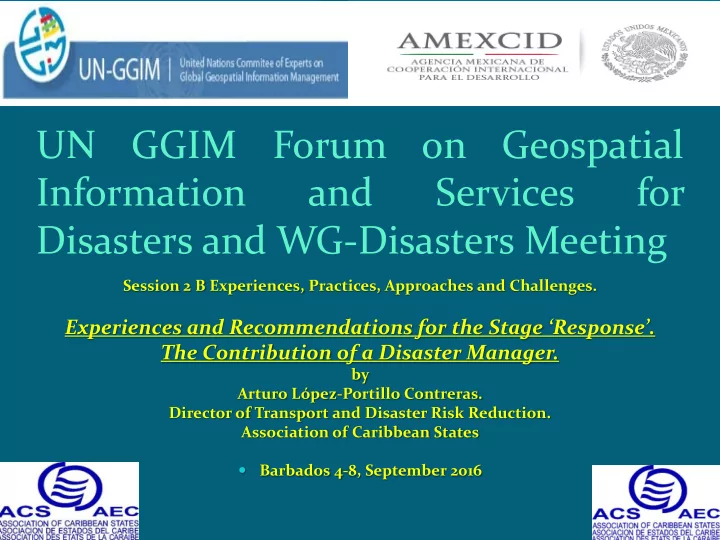

UN GGIM Forum on Geospatial Information and Services for Disasters and WG-Disasters Meeting Session 2 B Experiences, Practices, Approaches and Challenges. Experiences and Recommendations for the Stage ‘Response’. The Contribution of a Disaster Manager. by Arturo López-Portillo Contreras. Director of Transport and Disaster Risk Reduction. Association of Caribbean States Barbados 4-8, September 2016
0.0 min
What is Response? Phase response Emergency cycle Disaster cycle During disasters Stage response of Disaster Risk Stage response of Disaster Management Response The provision of emergency services and public assistance during or immediately after a disaster in order to save lives, reduce health impacts, ensure public safety and meet the basic subsistence needs of the people affected. (UNISDR 2009) ?? Unforeseen or sudden occurrence especially danger, demanding immediate action
From ‘Carter, Nick. Disaster Management. ADB. 1992.’
From ‘Carter, Nick. Disaster Management. ADP. 1992.
Disaster Cycle Disaster management components are not all sequential Not all disaster management activities necessary occur in a hazard impact. Not all hazards create a disaster Assumes disaster cannot be avoided. Creates the idea that disasters will occur for ever
Disaster Management Continuum τ ° τ 1 τ 2 τ 3 τ 4 τ 5 τ 6 τ 7 τ8 Permanent Immediately Durin Immediately Long Term & Permanent before g after Permanent δ 1 Disaster δ1 Disaster Management Interruption/change of Activity Information Mgmnt. Inf. δ 2 Preparedness δ2 Interruption/change of Activity Preparedness δ 3 Mitigation δ 3 Interruption/change of Activity Mitigation δ4 Response δ5 Relief δ6 Rehabilitatio n δ7 Reconstruction ° T Recovery i
Stages/Phases of Disaster Management Disaster Management (Every phenomenon) activities can be divided into three stages: Before the threat or impact of a hazard During an emergency or a disaster After an emergency or a disaster
Stage «During» = Response The stage that comprises activities taken from warning to the finalization of the damage and needs assessment report (damage and loss assessment or PDNA) that allows the reconstruction to start. Hazards Impact Effects, consequences Response activities (functions) Responsibilities
t0 t1 t2 t3 Warning Notification Emergency Public Information
t0 Threat t1 Impact t2 Disaster Relief starts t3 Rehabilitation t4 Reconstruction Warning Notification Emergency Public Information EOC Coordination Evacuation Security Shelter Management Damage and Needs Assessment Search and Rescue Medical Attention and Environmental Health Clean-up and Waste Disposal Relief Rehabilitation of Public Utilities and Services Reconstruction
What information is needed for Disaster Risk Management?
Warning Areas at risk Floodplains Scope of impact for volcanic eruptions and tsunami, etc. Coastal areas affected Vulnerable settlements Population (age, gender, language, etc) Housing Critical infrastructure
Notification Government offices Critical infrastructure National DRM organisations at all levels All government, private and social responders
Emergency Public Information General public Media TV Networks radio stations
Evacuation Population at risk Location of shelters Routes
Shelter Management Location of shelters Capacity Needs
Security Critical facilities Prisons Supermarkets Stores
Search and Rescue Areas impacted Buildings collapses Areas flooded Boats lost in the sea
Medical Attention and Environmental Health Hospitals Clinics Ambulances Areas impacted Population affected Cemetaries Routes
Clean up and waste disposal Roads blocked Areas impacted Critical facilities Hospitals Shelters Areas covered with debris Waste disposal areas
Relief Airports Maritime ports Warehouses Hotels EOCs Areas impacted Needs Shelters and needs
Rehabilitation of Public Utilities and Services Damage to PU Status of roads Warehouses Response teams Antennas, communications equipment Power generation sub stations Water storage and supply
Emergency Operations Centres All information! General coordination Resource management Monitoring evolution of the hazard/disaster Monitoring of IDPs, shelters, relief goods, etc. Status of PU Damage and needs Back to normalcy
How can it be done? Coordination GI & S – DRM: all the time Committees participation of DRM Office Participation of Ministries/Sectors. Education, Security, Health, Tourism, etc. Everything prepared in the stage before. Protocol.
How can it be done? Establish a Committe Members: GI & S; NEMO, Ministries, Private Sector, NGOs Identify needs based on hazard and effects Identifiy responsibilities based on response needed (Emergency Response Functions) Identify items to be mapped Update Design and update (Stage before) Access USE: Stage during : Response. Improve
Final Recommendations Replace the term «emergency cycle» by emergency phase (or stage) of Disaster Risk Management (or Disaster Risk Reduction) replace «phases of the emergency cycle» by phases (or components) of DRM Include a section on Disaster Risk Management suggesting information that could be included in Gi & S (See previous slides) The phrase «before, during and after disasters» is ok. In this section some suggestions for the process to assist disaster managers could be includes: GI & S and DRM committee, with specific members (see previous slides) Design of a protocol in this committee that indicates responsibilities, information needed for DRM etc. (Chile’s presentation)
Association of Caribbean States 25 member states: Antigua and Barbuda, Bahamas, Barbados, Belize, Colombia, Costa Rica, Cuba, Dominica, Dominican Republic, El Salvador, Grenada, Guatemala, Guyana, Haiti, Honduras, Jamaica, Mexico, Nicaragua, Panama, St. Kitts and Nevis, St. Lucia, St. Vincent and the Grenadines, Suriname, Trinidad and Tobago, Venezuela. Associate Members: Aruba, Curacao, France on behalf of (French Guiana, Saint Barthelemy and Saint Martin), Guadeloupe, Martinique, Sint Maarten and The Netherlands Antilles on behalf of (Saba and Sint Eustatius).
Association of Caribbean States Collaboration and technical cooperation amongst country members. Disaster Reduction, Transport, Trade, Tourism. Disaster Reduction projects: UNGGIM: 19 countries. Caribbean Territorial Information Platform for Disaster Prevention (PITCA)
Association of Caribbean States Disaster Projects: 19 countries with GI & S and Disaster Management Information. Disaster Management supported by GI & S In countries Subregional Regional UWI
Association of Caribbean States Countries Members and Associates Meetings (Heads of State, Presidents) UNGGIM 3-7 October Mexico City. Special Committees (21 October TnT) CARICOM CDEMA UWI sustainability Countries
4:58
4:59
5:00
Recommend
More recommend